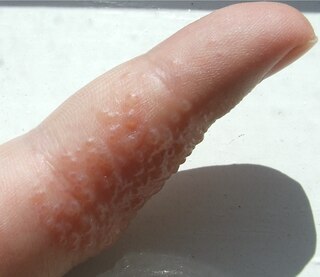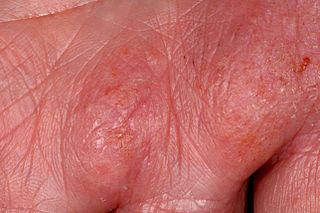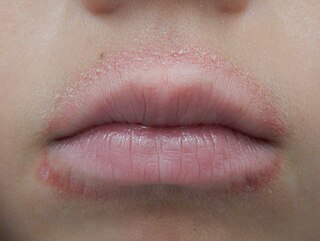Related Research Articles

Dermatitis is inflammation of the skin, typically characterized by itchiness, redness and a rash. In cases of short duration, there may be small blisters, while in long-term cases the skin may become thickened. The area of skin involved can vary from small to covering the entire body. Dermatitis is often called eczema, and the difference between those terms is not standardized.

Contact dermatitis is a type of acute or chronic inflammation of the skin caused by exposure to chemical or physical agents. Symptoms of contact dermatitis can include itchy or dry skin, a red rash, bumps, blisters, or swelling. These rashes are not contagious or life-threatening, but can be very uncomfortable.

Latex allergy is a medical term encompassing a range of allergic reactions to the proteins present in natural rubber latex. It generally develops after repeated exposure to products containing natural rubber latex. When latex-containing medical devices or supplies come in contact with mucous membranes, the membranes may absorb latex proteins. In some susceptible people, the immune system produces antibodies that react immunologically with these antigenic proteins. Many items contain or are made from natural rubber, including shoe soles, pen grips, hot water bottles, elastic bands, rubber gloves, condoms, baby-bottle nipples, and balloons; consequently, there are many possible routes of exposure that may trigger a reaction. People with latex allergies may also have or develop allergic reactions to some fruits, such as bananas.
An occupational disease or industrial disease is any chronic ailment that occurs as a result of work or occupational activity. It is an aspect of occupational safety and health. An occupational disease is typically identified when it is shown that it is more prevalent in a given body of workers than in the general population, or in other worker populations. The first such disease to be recognised, squamous-cell carcinoma of the scrotum, was identified in chimney sweep boys by Sir Percival Pott in 1775. Occupational hazards that are of a traumatic nature are not considered to be occupational diseases.

Dyshidrosis is a type of dermatitis that is characterized by itchy blisters on the palms of the hands and bottoms of the feet. Blisters are generally one to two millimeters in size and heal over three weeks. However, they often recur. Redness is not usually present. Repeated attacks may result in fissures and skin thickening.

A patch test is a diagnostic method used to determine which specific substances cause allergic inflammation of a patient's skin.
Cocamidopropyl betaine (CAPB) is a mixture of closely related organic compounds derived from coconut oil and dimethylaminopropylamine. CAPB is available as a viscous pale yellow solution and it is used as a surfactant in personal care products and animal husbandry. The name reflects that the major part of the molecule, the lauric acid group, is derived from coconut oil. Cocamidopropyl betaine to a significant degree has replaced cocamide DEA.

Glochids or glochidia are hair-like spines or short prickles, generally barbed, found on the areoles of cacti in the sub-family Opuntioideae. Cactus glochids easily detach from the plant and lodge in the skin, causing irritation upon contact. The tufts of glochids in the areoles nearly cover the stem surfaces of some cactus species, each tuft containing hundreds of glochids; this may be in addition to, or instead of, the larger, more conspicuous cactus spines, which do not readily detach and are not generally barbed.
Irritant contact dermatitis is a form of contact dermatitis that can be divided into forms caused by chemical irritants and those caused by physical irritants.

Cheilitis is a medical condition characterized by inflammation of the lips. The inflammation may include the perioral skin, the vermilion border, or the labial mucosa. The skin and the vermilion border are more commonly involved, as the mucosa is less affected by inflammatory and allergic reactions.

Hand eczema presents on the palms and soles, and may sometimes be difficult or impossible to differentiate from atopic dermatitis, allergic contact dermatitis, and psoriasis, which also commonly involve the hands. Even a biopsy of all these conditions may not result in a definitive diagnosis, as all three conditions may demonstrate spongiosis and crusting on the hands.
Id reactions are types of acute dermatitis developing after days or weeks at skin locations distant from the initial inflammatory or infectious site. They can be localised or generalised. This is also known as an 'autoeczematous response' and there must be an identifiable initial inflammatory or infectious skin problem which leads to the generalised eczema. Often intensely itchy, the red papules and pustules can also be associated with blisters and scales and are always remote from the primary lesion. It is most commonly a blistering rash with itchy vesicles on the sides of fingers and feet as a reaction to fungal infection on the feet, athlete's foot. Stasis dermatitis, allergic contact dermatitis, acute irritant contact eczema and infective dermatitis have been documented as possible triggers, but the exact cause and mechanism is not fully understood. Several other types of id reactions exist including erythema nodosum, erythema multiforme, Sweet's syndrome and urticaria.
A barrier cream is a topical formulation used in industrial applications and as a cosmetic to place a physical barrier between the skin and contaminants that may irritate the skin. There are many other terms for creams designed to protect skin from harmful substances, including skin protective creams, pre-work creams, antisolvent gels, protective ointments, and shielding lotions. Three classes of barrier creams are used: water repellent creams, water-soluble creams, and creams designed for special applications. Barrier creams may contain substances such as zinc oxide, talc or kaolin to layer over the skin. For hand care they are designed to protect against the harm from detergents and other irritants.
Contact stomatitis is inflammation or pain of the oral mucosa caused by external stimuli. It is characterized by cutaneous lesions that may be located where the offending agent contacts the mucosa for a prolonged time. Oftentimes it presents in the mouth after contact with hot food or from ill-fitted dentures or other irritant. Consequently, patients may seek resolve from their dentist rather than a dermatologist. Unlike with allergic contact stomatitis, the skin requires no previous exposure to a stimulant before crafting an immune reaction.
Lepidopterism is an irritant contact dermatitis caused by irritating caterpillar or moth hairs coming into contact with the skin or mucosa. When referring to the cause, moth dermatitis and caterpillar dermatitis are commonly used; Caripito itch is an older name referring to the moth dermatitis caused by some Hylesia species.

Garlic allergy or allergic contact dermatitis to garlic is a common inflammatory skin condition caused by contact with garlic oil or dust. It mostly affects people who cut and handle fresh garlic, such as chefs, and presents on the tips of the thumb, index and middle fingers of the non-dominant hand. The affected fingertips show an asymmetrical pattern of fissure as well as thickening and shedding of the outer skin layers, which may progress to second- or third-degree burn of injured skin.
Sensitive skin is a skin condition in which skin is prone to itching and irritation experienced as a subjective sensation when using cosmetics and toiletries. When questioned, over 50% of women in the UK and US, and 38% of men, report that they have sensitive skin.

Nickel allergy is any of several allergic conditions provoked by exposure to the chemical element nickel. Nickel allergy often takes the form of nickel allergic contact dermatitis (Ni-ACD), a form of allergic contact dermatitis (ACD). Ni-ACD typically causes a rash that is red and itchy and that may be bumpy or scaly. The main treatment for it is avoiding contact with nickel-releasing metals, such as inexpensive jewelry. Another form of nickel allergy is a systemic form: systemic nickel allergy syndrome (SNAS) can mimic some of the symptoms of irritable bowel syndrome (IBS) and also has a dermatologic component.

Lip licker's dermatitis is a type of skin inflammation around the lips due to damage by saliva from repetitive lip licking and is classified as a subtype of irritant contact cheilitis. The resulting scaling, redness, chapping, and crusting makes a well-defined ring around the lips. The rash may extend as far as the tongue can reach and usually does not occur at the corners of the mouth. It commonly occurs during winter months but some people can have it year-round if lip licking is a chronic habit.
The intense contact between a musical instrument and skin may exaggerate existing skin conditions or cause new skin conditions. Skin conditions like hyperhidrosis, lichen planus, psoriasis, eczema, and urticaria may be caused in instrumental musicians due to occupational exposure and stress. Allergic contact dermatitis and irritant contact dermatitis are the most common skin conditions seen in string musicians.
References
- ↑ Kanerva's Occupational Dermatology. ISBN 978-3-642-02035-3.
- ↑ Chew, Ai-Lean; Maibach, Howard I. (18 June 2006). Irritant Dematitis. ISBN 978-3-540-31294-9.
- ↑ Coenraads, P. J.; Diepgen, T. L. (1998-02-01). "Risk for hand eczema in employees with past or present atopic dermatitis". International Archives of Occupational and Environmental Health. 71 (1): 7–13. doi:10.1007/s004200050243. ISSN 0340-0131. PMID 9523243. S2CID 24878837.
- ↑ Elsner, P. (1994-07-01). "Irritant dermatitis in the workplace". Dermatologic Clinics. 12 (3): 461–467. doi:10.1016/S0733-8635(18)30149-9. ISSN 0733-8635. PMID 7923942.
- ↑ Safety, Government of Canada, Canadian Centre for Occupational Health and. "Dermatitis, Irritant Contact : OSH Answers". www.ccohs.ca. Retrieved 2016-03-25.
- ↑ Glove-related hand urticaria: an increasing occupational problem amongst health care workers. Hawkey S, Abdul Ghaffar S.
- ↑ Wilhelm, Klaus Peter; Zhai, Hongbo; Maibach, Howard I. (26 November 2007). Dermatotoxicology. ISBN 978-0849397738.
- ↑ Eichmann, A.; Amgwerd, D. (1992-05-05). "[Toxic contact dermatitis]". Schweizerische Rundschau für Medizin Praxis = Revue Suisse de Médecine Praxis. 81 (19): 615–617. ISSN 1013-2058. PMID 1589676.
- ↑ Dahl, M. V. (1988-01-01). "Chronic, irritant contact dermatitis: mechanisms, variables, and differentiation from other forms of contact dermatitis". Advances in Dermatology. 3: 261–275. ISSN 0882-0880. PMID 3152823.
- ↑ handbook of occupational dermatology.
- ↑ Bauer A, Rönsch H, Elsner P, Dittmar D, Bennett C, Schuttelaar MA, Lukács J, John S, Williams HC. Interventions for preventing occupational irritant hand dermatitis. Cochrane Database of Systematic Reviews 2018, Issue 4. Art. No.: CD004414. DOI: 10.1002/14651858.CD004414.pub3